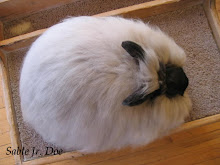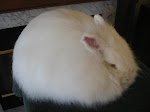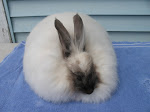There is nothing like a litter of bunnies to brighten up a long, dark, winter:-). Here in NY we have been enduring one of the worst winters in almost 20 years, with abnormally low temps for our area and a whole lot of precipitation. The bunnies for the most part have held up well with lots of running back and forth to thaw and refill water dishes, add hot water to 'almost' frozen dishes, and scrape cage pans with ice scrapers and rinse them off in hot water in the absence of a working hose, LOL. Winter is tough under any circumstances if you have livestock, but the nice thing about angoras is that you can pretty much be sure that no one is cold in any temperature as long as there is a 1/2 inch of wool on them, and the water is liquid and warm (bunny tea is the beverage of choice in sub zero temps:)).
Breeding-wise it has been a different story, with much more difficulty. I bred three does a month ago and all seemed receptive at the time, but unfortunately only one kindled. I switched back to my trusty Heinold feed so hopefully this will help, but the lack of litters are mostly due to the awful weather conditions IMO, and are being shared by most of the rabbit breeders in my area from what I have heard.
Anyway, so a litter of 6 was born to Morwenna and Henryi on 1/25 with one stillborn. When I got out to the barn to check her, she had buried 4 of the babies in the back of her nestbox to keep them warm, but 2 were exposed in the front of the box in 5 degree temps:(. I grabbed the box and ran it into the house. One of the kits was already gone and the sac still covered it's face, but the other was cleaned and moving very very slightly, so we set up a heat lamp and laid the baby on a towel beneath it.
*Just a word about heat lamps, btw. As anyone who has ever raised chicks or other animals knows, a heat lamp is a potentially dangerous 'tool' because it can start fires and overheat a baby or litter to the point of death. I have used heat lamps in the past to heat entire litters who were scattered at birth, and I use it to heat individual babies too, but very, very carefully. It is extremely important not to heat a cold baby too quickly when you first find it. The core body temperature must be raised slowly in order to avoid shock, and I began by putting this baby in a warm place in the sunshine at first until it began to take deep breaths. At that point I turned the lamp on but mounted it very high above the kit, and as the baby became more active I moved it closer still (constantly checking the heat levels). I sat at the table next to the baby while it was rehabilitating so that I could keep very close tabs on it, and once it became active I began flipping it from side to side to warm it evenly (as one might a little bunny burrito, LOL!). I took a warm, wet washcloth at one point and briskly rubbed it down also until it squeaked, and then left it alone again to keep heating.
After about an hour of recuperation the baby was very warm to the touch (which it needed to be before putting it back in the nest), and I put it on the bottom of the bunny pile in the nest of clipped up wool and hay. It is important to mention here (just for those who have never have done this before), that a kit can appear absolutely 100% dead with no signs of life whatsoever, but still come back to life if the right treatment is used and you are willing to wait. I have to admit that I practically wrote this baby off because it didn't move for a solid 10 minutes, but with a little more time it began to come around again, and after an hour of slow warming it was ready to join it's littermates.
Here is a picture of the 'dead' kit taken about a half hour after coming inside. In this photo it is just beginning to stretch it's front legs:

This is the bunny nest after each kit was taken out, checked, and counted, and the wool was clipped, cleaned, and replaced.
 And this is the sleeping bunch as of this morning at 1 week old. Everyone is nursing well and looking fabulous, and Mom is doing a wonderful job of keeping everyone clean and full:). At this point it looks as though there are 3 Torts and 2 Fawns, which was what was expected given the color of the parents. Once the PA show is over we will breed 5-6 more girls, and hopefully many more litters will join the herd.
And this is the sleeping bunch as of this morning at 1 week old. Everyone is nursing well and looking fabulous, and Mom is doing a wonderful job of keeping everyone clean and full:). At this point it looks as though there are 3 Torts and 2 Fawns, which was what was expected given the color of the parents. Once the PA show is over we will breed 5-6 more girls, and hopefully many more litters will join the herd.























No comments:
Post a Comment